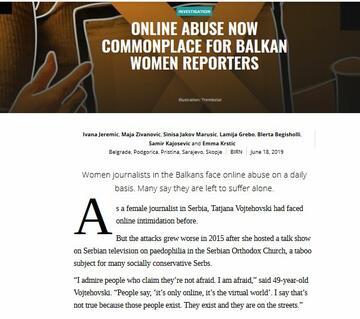
Related contents
Newsroom Best Practices for Addressing Online Violence against JournalistsHate speech: what it is and how to contrast it
Media freedom in Montenegro: a survey of publications
Manifesto of Venice against gender-based violence
#SOFJO campaign for the safety of female journalists online
The Background
“In a 2018 survey by the Washington-based International Women’s Media Foundation, IWMF, nearly two thirds of women journalists who responded said they had been threatened or harassed online at least once. Also in 2018, the International Federation of Journalists, IFJ, reported that 66 per cent of women journalists who were victims of online harassment had been attacked based on their gender”. According to this investigation, the situation in the Western Balkans is even worse.
The Findings
As in other countries, attacks on women journalists usually consist of “sexist insults and humiliation based on their physical appearance, rape threats and other gender-based attacks, which male journalists are not subjected to”. In the Balkans – this is the main finding of this investigation – women journalists face online abuse on a daily basis.
Safejournalist.net has documented 34 attacks in general against women journalists in Bosnia since 2015, 32 in Serbia, 13 in Kosovo, 10 in North Macedonia, and 8 in Montenegro.
Reaffirming that online abuse against women journalists is a “growing global epidemic”, the report is open to new stories thanks to the possibility of joining an online platform managed by BIRN: women are invited to tell their “experience facing online violence as a female journalist in the Balkans, whether it's attacks, harassment or threats”.
One of the most shared recommendations is that a link should be found between journalists and women's civil society organisations, beside building networks of female journalists. Laws are usually sufficient to prosecute the offenders, there is no need to add other legal tools, but their implementation needs to be improved.
According to most of the interviewed journalists, the persistence of gender-based stereotypes creates a difficult environment for women. Media expert Mehmed Halilovic says: “female journalists in the Balkans faced a perfect storm of widespread misogyny and disdain for journalists in general”.
Tags: Safety of journalists Media and gender Hate speech Impunity Online news Online media Bosnia Herzegovina Serbia Kosovo North Macedonia MontenegroThe content of this article can be used according to the terms of Creative Commons: Attribution-NonCommercial 4.0 International (CC BY-NC 4.0) . To do so use the the wording "this article was originally published on the Resource Centre on Media Freedom in Europe" including a direct active link to the original article page.

